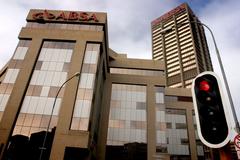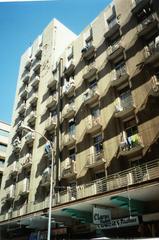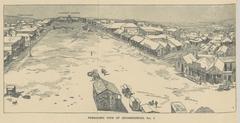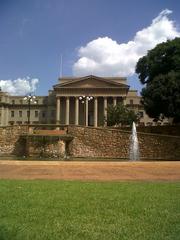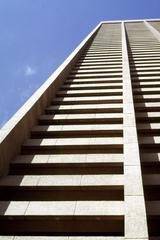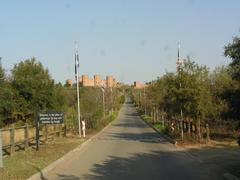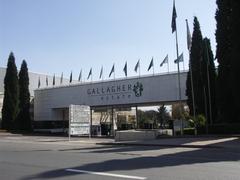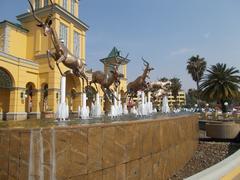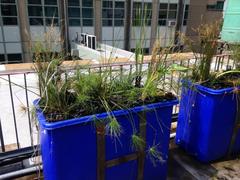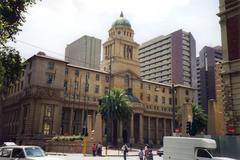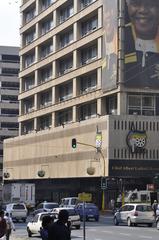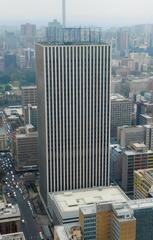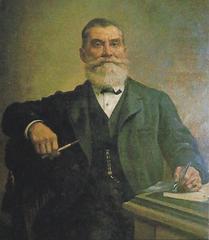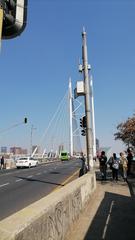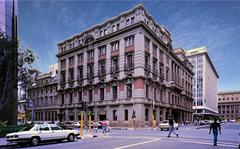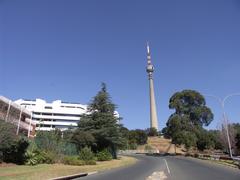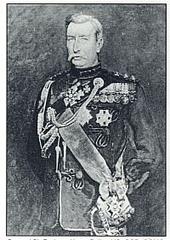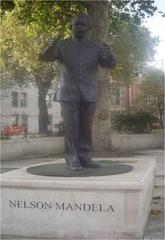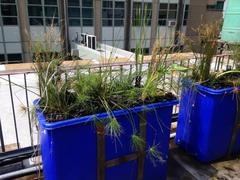Ansteys Building Johannesburg Visiting Hours, Tickets, and Historical Sites Guide
Date: 14/06/2025
Introduction
Nestled in the vibrant heart of Johannesburg’s Central Business District, the Ansteys Building is a celebrated emblem of the city’s Art Deco heritage and urban transformation. Completed in 1937 and designed by the renowned firm Emley & Williamson, this 20-storey skyscraper was commissioned by Norman Anstey, a visionary entrepreneur and former mayor. Originally housing a prestigious department store and luxury apartments, Ansteys Building has come to symbolize Johannesburg’s era of economic optimism and its enduring spirit of renewal. Today, it stands as a protected heritage site, drawing architecture enthusiasts, cultural tourists, and history lovers alike (Heritage Portal; VISI; Wikipedia).
This guide offers comprehensive, up-to-date information on Ansteys Building’s visiting hours, ticketing, accessibility, architectural features, cultural significance, and practical tips for travelers. Discover why Ansteys remains a must-see destination among Johannesburg historical sites.
Table of Contents
- Historical Background and Architectural Context
- Art Deco Design and Features
- Preservation, Community, and Heritage Status
- Visiting Hours, Tickets, and Accessibility
- Guided Tours and Special Events
- Travel Tips and Nearby Attractions
- Visitor Experience and Photography
- FAQs
- Conclusion and Traveler Tips
- References
Historical Background and Architectural Context
Early Development and Vision
Ansteys Building’s roots lie in the entrepreneurial spirit of Norman Anstey, who established the original Ansteys department store in 1907. By the 1930s, Johannesburg was experiencing unprecedented growth, and Anstey envisioned a flagship complex reflecting both commercial success and contemporary international trends. The third and current Ansteys Building was constructed between 1935 and 1937, at the intersection of Joubert and Jeppe Streets, becoming a prominent feature of the city’s rapidly changing skyline (Heritage Portal).
Architectural Significance
Designed by Emley & Williamson, Ansteys is a quintessential example of high Art Deco architecture. Its distinctive ziggurat (stepped) form, rounded corners, and curved glass windows reflect the influence of New York skyscrapers and the modernist design ethos of the interwar period (VISI; Artefacts). Rising 20 storeys, with a dramatic flag mast atop, it was one of Africa’s tallest buildings at the time and a symbol of Johannesburg’s ambition.
Role in Johannesburg’s Urban Identity
Ansteys was part of a quartet of skyscrapers that defined Johannesburg’s central skyline for decades (Heritage Portal). Its prominence and innovative design made it a beacon of modernity, while its department store and luxury apartments positioned it at the heart of the city’s commercial and social life.
Art Deco Design and Features
- Stepped Ziggurat Silhouette: Created in response to city bylaws, the building’s setbacks allowed sunlight to reach street level and gave Ansteys its iconic profile.
- Curved Façade and Ribbon Windows: The podium’s sweeping curves and horizontal window bands typify Art Deco’s streamlined, geometric elegance (Wikipedia).
- Modern Materials: Use of terrazzo, glass, and steel, with vertical piers and cylindrical glazed windows, underscore the building’s modernist aesthetic (e-a-a.com).
- Decorative Elements: Stylized sunbursts, zigzag motifs, and the dramatic flag mast crown the building’s exterior, while marble floors and brass fittings once adorned the interiors.
Preservation, Community, and Heritage Status
Decline and Revival
After its heyday, the building faced urban decline in the late 20th century, with the closure of the department store and proposals for demolition. A vigorous preservation campaign led by local heritage advocates saved Ansteys, resulting in restoration and adaptive reuse as a mixed-use building with residential apartments and commercial spaces (Heritage Portal).
Heritage Recognition
Ansteys is now a declared Provincial Heritage Site, protected for its architectural and cultural significance (Heritage Register). Restoration efforts continue, ensuring the building’s legacy for future generations (The Heritage Portal).
Community and Cultural Role
Today, Ansteys houses a diverse community of residents—artists, professionals, and families—and serves as a creative hub with galleries, studios, and periodic cultural events (Johannesburg Heritage Foundation). Its adaptive reuse demonstrates the dynamic potential of historic buildings in contemporary urban life.
Visiting Hours, Tickets, and Accessibility
Visiting Hours
- Monday–Friday: 9:00 AM to 5:00 PM
- Weekends & Public Holidays: Guided tours and special events by appointment or as scheduled. Check with local heritage groups or the building’s management for up-to-date info.
Tickets and Guided Tours
- General Entry: The building is primarily residential; public access to common areas is limited. Viewing the exterior is always available.
- Guided Tours: Organized by local heritage organizations, typically operating during daytime hours. Advance booking is recommended. Tickets range from R150 to R300 per person (as of 2025).
- Special Events: Art Deco festivals, open studios, and heritage days occur periodically—monitor official channels for announcements.
Accessibility
- Wheelchair Access: Ramps, elevators, and accessible sidewalks are available, though some areas may have limited access. Contact tour operators for specific needs.
Guided Tours and Special Events
Guided heritage walks frequently include Ansteys as part of broader explorations of Johannesburg’s Art Deco and historical landmarks. Some tours offer interior access, including the main lobby and rooftop, providing historical context and panoramic city views (Rough Guides). Special community events, such as art exhibitions and open days, showcase Ansteys’ creative energy.
Travel Tips and Nearby Attractions
Location
- Address: 59 Joubert Street, Johannesburg CBD
- Transport: Accessible via Gautrain, Rea Vaya buses, and ride-hailing services. Limited parking in the CBD; public transport is recommended.
Safety
Remain aware of your surroundings, especially after dark. Guided tours and group visits are advisable.
Nearby Attractions
- Johannesburg Art Gallery: South Africa’s premier public art museum.
- Constitution Hill: Historic fort and museum chronicling the nation’s journey to democracy (Holidify).
- Carlton Centre: Africa’s tallest building with panoramic views.
- Neighbourgoods Market: Lively weekend market in nearby Braamfontein (The Crazy Tourist).
Visitor Experience and Photography
- What to See: Admire Ansteys’ façade from the corner of Joubert and Rahima Moosa Streets. Guided tours may include the main lobby, select apartments, and rooftop terrace.
- Best Time to Visit: Mild, dry winter months (May–August) are ideal for walking tours (Global Highlights).
- Photography: The building’s Art Deco features and city views are highly photogenic. Respect resident privacy and request permission when photographing private spaces.
Frequently Asked Questions (FAQ)
Q: What are the Ansteys Building visiting hours?
A: Guided tours operate Monday to Saturday, 9:00 AM to 5:00 PM. Exterior viewing is possible at any time.
Q: Is there an entrance fee?
A: Exterior viewing is free. Guided tours require tickets (R150–R300; advance booking recommended).
Q: Can I access the rooftop?
A: Rooftop access is possible on select guided tours.
Q: Is Ansteys Building wheelchair accessible?
A: Yes, but some areas may have limitations. Contact ahead for details.
Q: Are photos allowed?
A: Yes, in public and exterior areas; please ask before photographing residents or private spaces.
Q: What attractions are nearby?
A: Johannesburg Art Gallery, Constitution Hill, Carlton Centre, and Neighbourgoods Market.
Conclusion and Traveler Tips
Ansteys Building is a living testament to Johannesburg’s architectural innovation, social evolution, and cultural resilience. Its Art Deco grandeur, layered history, and vibrant community make it a must-visit among Johannesburg historical sites. To make the most of your visit:
- Book guided tours in advance for interior and rooftop access.
- Explore nearby heritage attractions for a fuller experience.
- Use public transport for convenience and safety.
- Download the Audiala app and follow local heritage organizations for updates on events, tours, and preservation initiatives.
By engaging with Ansteys, visitors not only encounter Johannesburg’s rich past but also support the ongoing vitality of its urban cultural landscape.
References
- Heritage Portal, 2025, Various Authors
- VISI, 2025, Building an Icon: Ansteys Building
- Wikipedia, 2025, Ansteys Building
- Artefacts, 2025, Ansteys Building
- Johannesburg Heritage Foundation, 2025, Ansteys Building
- Rough Guides, 2025, Johannesburg Weather and Travel Tips
- The Heritage Portal, 2025, Ansteys Building Article Categories
- Holidify, 2025, Johannesburg Sightseeing
- The Crazy Tourist, 2025, Best Things to Do in Johannesburg
- Global Highlights, 2025, South Africa Weather in June
- Heritage Register
- e-a-a.com, 2025, 10 Best Architectural Buildings in Johannesburg

